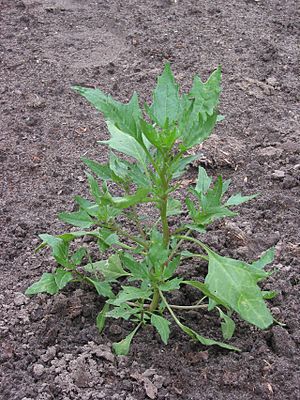Oxybasis rubra facts for kids
Oxybasis rubra (also known as red goosefoot or coastblite goosefoot) is a type of plant that belongs to the Oxybasis family. It used to be grouped with other plants in the Chenopodium family, but scientists have now given it its own group. This plant is found naturally in North America and Eurasia. It is an annual plant, which means it completes its entire life cycle, from seed to flower to seed, within one year.
Quick facts for kids Oxybasis rubra |
|
|---|---|
 |
|
| Scientific classification | |
| Genus: |
Oxybasis
|
| Species: |
rubra
|
| Synonyms | |
|
|
Contents
Where Red Goosefoot Grows
Oxybasis rubra is found in many places around the world. It is native to both North America and Eurasia. This means it has grown naturally in these areas for a very long time.
Conservation Status in the United States
In some parts of the United States, Oxybasis rubra is becoming rare. Its conservation status shows how much protection it needs:
- In Connecticut, it is a "special concern" plant. This means it is being watched closely because it might disappear. It is also believed to be "extirpated," which means it no longer grows there naturally.
- In New Jersey, it is listed as "endangered." This means it is at very high risk of disappearing from the wild.
- In Maine, New Hampshire, and New York, it is listed as "threatened." This means it is likely to become endangered in the near future.
Traditional Uses by Native Americans
Native American tribes have a long history of using plants for food, medicine, and other purposes. This is called ethnobotany.
Food Source for the Goshute Shoshone
The Goshute Shoshone people, who live in Utah, traditionally used the seeds of Oxybasis rubra as a food source. They would likely gather the seeds and prepare them in various ways, perhaps by grinding them into flour. In the Goshute Shoshone language, this plant has several names, including on’-tǐm-pi-wa-tsǐp, on’-tǐm-pi-wa, on’-tǐm-pi-a-wa, or on’-tǐm-pai-wa.
See also

- In Spanish: Chenopodium rubrum para niños

